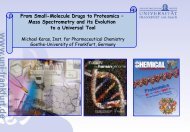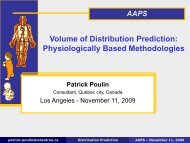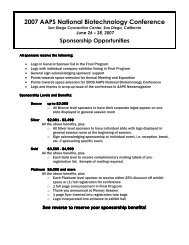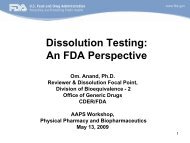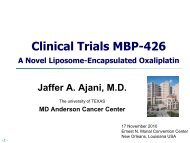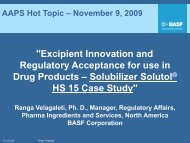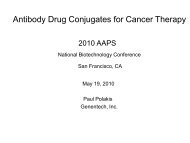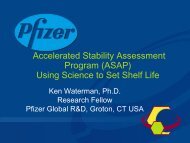Criticality Assessment- Identification of Critical Quality Attributes ...
Criticality Assessment- Identification of Critical Quality Attributes ...
Criticality Assessment- Identification of Critical Quality Attributes ...
Create successful ePaper yourself
Turn your PDF publications into a flip-book with our unique Google optimized e-Paper software.
<strong><strong>Critical</strong>ity</strong> <strong>Assessment</strong>- <strong>Identification</strong> <strong>of</strong> <strong>Critical</strong><br />
<strong>Quality</strong> <strong>Attributes</strong> (CQA) & <strong>Critical</strong> Process<br />
Parameter (CPP) for a MR Dosage form (DP)<br />
Shailesh Singh, Nirdosh Jagota, T.G. Venkateshwaran, &<br />
Richard Saunders<br />
AAPS Annual Meeting, November 2009<br />
Pfizer • 0
Outline<br />
� Define product goal via establishment <strong>of</strong> <strong>Quality</strong> target product<br />
Pr<strong>of</strong>ile (QTPP)<br />
� Determination <strong>of</strong> <strong>Critical</strong> <strong>Quality</strong> <strong>Attributes</strong> (CQAs)-Identify the<br />
CQAs based on prior knowledge and QTPP<br />
� Use prior knowledge and risk assessment to identify the critical<br />
parameters or attributes. Establish link between CPP & CQAs. Use<br />
risk management techniques to prioritize the parameters to study.<br />
� Establishment <strong>of</strong> <strong><strong>Critical</strong>ity</strong>- CPP & CQA<br />
� Provide key learning from company experience and future<br />
directions<br />
1<br />
Pfizer • 1
QbD Road Map – FDA Interpretation<br />
<strong>Quality</strong><br />
by<br />
Design<br />
Continually<br />
monitor and<br />
update process to<br />
assure consistent<br />
quality<br />
Identify and<br />
control critical<br />
attributes in<br />
material and<br />
process<br />
*: Based on slides by Dr. Nasr, FDA, Feb 07<br />
Product & process design and development<br />
Define desired<br />
product performance<br />
upfront;<br />
identify product CQAs<br />
QRM and Knowledge Management<br />
Design formulation<br />
and process to meet<br />
product CQAs<br />
QRM and Knowledge Management<br />
Understand impact <strong>of</strong><br />
material attributes<br />
and process<br />
parameters on<br />
product CQAs<br />
Pfizer • 2
<strong>Quality</strong> Target Product Pr<strong>of</strong>ile – Beginning<br />
with the end in mind<br />
� Natural extension <strong>of</strong> the Target Product pr<strong>of</strong>ile for product quality<br />
� Prospective summary <strong>of</strong> the quality characteristics <strong>of</strong> the drug product taking<br />
into account the safety, efficacy (and manufacturability) <strong>of</strong> the drug product<br />
� Factors to be considered<br />
– Identify <strong>Critical</strong> <strong>Quality</strong> <strong>Attributes</strong> <strong>of</strong> the Drug Product<br />
– Route <strong>of</strong> Administration (Oral versus Intravenous drug product)<br />
– Type <strong>of</strong> dosage form (Immediate versus modified release)<br />
– High dose versus low dose<br />
– Target population<br />
– Type <strong>of</strong> therapy (life saving versus quality <strong>of</strong> life)<br />
� Consideration should also be given to:<br />
– Clinical usage Setting<br />
– Supply chain requirements<br />
– Special region/market requirements (e.g.) Japanese requirements for<br />
appearance<br />
Pfizer • 3
Example <strong>of</strong> a <strong>Quality</strong> Target Product Pr<strong>of</strong>ile<br />
<strong>Quality</strong> Attribute<br />
Target Product Pr<strong>of</strong>ile<br />
Target <strong><strong>Critical</strong>ity</strong><br />
Dosage form ER, Film coated Tablet (
Prior Knowledge<br />
� Summarize all Prior Knowledge<br />
– Include all sources <strong>of</strong> knowledge :Literature, patents,<br />
notes, company and personal experience with projects.<br />
– Knowledge from experience with (similar) prior projects<br />
with reference to API, drug product, material properties<br />
<strong>of</strong> components, manufacturing process, equipments,<br />
test methods, deviations, etc.<br />
Pfizer • 5
<strong><strong>Critical</strong>ity</strong> Analysis<br />
�<strong><strong>Critical</strong>ity</strong> is used to describe any feature or<br />
material attribute, property or characteristic <strong>of</strong> a<br />
drug substance, component, raw material, drug<br />
product or device and/or any process attribute,<br />
parameter, condition, variable or factor in the<br />
manufacture <strong>of</strong> a drug product.<br />
ISPE: <strong><strong>Critical</strong>ity</strong> paper in JPI, 2008<br />
Pfizer • 6
Decision Tree to decide CQAs<br />
Prior<br />
Knowledge<br />
<strong>Quality</strong><br />
Attribute not<br />
a CQA<br />
<strong>Quality</strong> Attribute may not<br />
be a CQA but still be<br />
critical from a business<br />
perspective e.g. tablet<br />
thickness, appearance<br />
No<br />
Start<br />
Brainstorm list <strong>of</strong><br />
<strong>Quality</strong> <strong>Attributes</strong><br />
(potential CQAs)<br />
Is this a CQA<br />
(from a<br />
patient<br />
perspective)?<br />
Yes<br />
Apply suitable<br />
QRA tool to rank<br />
CQAs<br />
List <strong>of</strong> CQAs<br />
Unsure<br />
QTPP<br />
Experimental<br />
work to<br />
increase<br />
knowledge<br />
<strong>Critical</strong> <strong>Quality</strong> Attribute (CQA):<br />
A physical, chemical, biological or microbiological property<br />
or characteristic that should be within an appropriate limit,<br />
range, or distribution to ensure the desired product quality.<br />
Pfizer • 7
<strong>Critical</strong> <strong>Quality</strong> <strong>Attributes</strong> (CQA)<br />
Manufacturability<br />
<strong>Critical</strong> <strong>Quality</strong> <strong>Attributes</strong><br />
Safety & Efficacy<br />
Drug Product CQA’s<br />
Drug Substance CQA’s<br />
Raw Material CQA’s<br />
Identity; Assay;<br />
Microbiology; UDU;<br />
Mechanical & Physical<br />
Props.; Description;<br />
Purity; Dissolution;<br />
Taste; Odor<br />
Closely interlinked but not be identical<br />
Identity; Assay;<br />
Description; Purity;<br />
Physical Properties<br />
Material & Functional<br />
Properties<br />
Pfizer • 8
Input (Raw) Material Characterization<br />
� Understanding the impact <strong>of</strong> raw materials on product<br />
performance.<br />
� Sources <strong>of</strong> variability in excipients<br />
� Functionality or functional properties <strong>of</strong> excipients<br />
� Important excipient properties and associated physical<br />
test methods.<br />
� Potential impacts <strong>of</strong> excipient properties against tests<br />
that might be carried out<br />
Pfizer • 9
Impact <strong>of</strong> raw material variability to <strong>Quality</strong> <strong>of</strong><br />
product<br />
Fixed process<br />
Feed forward<br />
approach<br />
Flexible process<br />
<strong>Quality</strong> = f (Raw material , Process parameters,..)<br />
T. Kourti, A. Phar. Rev., 2008.<br />
Pfizer • 10
ISPE :PQLI Model for <strong>Quality</strong> <strong>Attributes</strong><br />
Continuum <strong>of</strong> <strong><strong>Critical</strong>ity</strong><br />
QTPP<br />
Potential<br />
Impact to Safety<br />
Efficacy &<br />
<strong>Quality</strong>?<br />
YES<br />
*A Severity Scale is used to assess<br />
relative magnitude <strong>of</strong> impact. A<br />
change in criticality only occurs w/<br />
a change in severity.<br />
ISPE <strong><strong>Critical</strong>ity</strong> Sub-team<br />
Severity*<br />
*Continual Improvement Iteration<br />
NO<br />
LOW RISK<br />
HIGH RISK<br />
Non-<strong>Critical</strong><br />
C<br />
R<br />
I<br />
T<br />
I<br />
C<br />
A<br />
L<br />
Pfizer • 11
Mapping the Linkage<br />
M1<br />
P2<br />
Inputs:<br />
P1<br />
M2<br />
Material <strong>Attributes</strong><br />
P3<br />
Process<br />
Parameters<br />
Outputs:<br />
CQA1<br />
CQA2<br />
CQA3<br />
Relationships:<br />
CQA1 = function (M1)<br />
CQA2 = function (P1, P3)<br />
CQA3 = function (M1, M2, P1)<br />
<strong>Critical</strong><br />
<strong>Quality</strong><br />
<strong>Attributes</strong><br />
P2 might not be needed in the<br />
establishment <strong>of</strong> design space<br />
Pfizer • 12
Prior Knowledge & Risk <strong>Assessment</strong><br />
� Summarize all Prior Knowledge<br />
– Include all sources <strong>of</strong> knowledge :Literature, patents, notes, company and<br />
personal experience with projects.<br />
– Knowledge from experience with (similar) prior projects with reference to<br />
API, drug product, material properties <strong>of</strong> components, manufacturing<br />
process, equipments, test methods, deviations, etc.<br />
� Risk assessment (ICH Q9)<br />
– Perform Initial risk assessment<br />
– Ensure all forms <strong>of</strong> risk are acceptable<br />
– Reduce potential variables to a manageable number.<br />
– Limited risk assessments, important to prevent bias; systematic risk<br />
analysis<br />
– Should be clear, concise and current, basis for defining criticality.<br />
� Prior knowledge and Risk assessment help in identifying the (knowledge<br />
gaps) potential variables & prioritize them for further studies.<br />
Pfizer • 13
Risk <strong>Assessment</strong> Tool Considerations<br />
Product<br />
Development<br />
Process<br />
Development<br />
Process Scale-up<br />
& Tech Transfer<br />
Manufacturing<br />
Platform / Prior Knowledge Specific Product Knowledge<br />
General Risks Specific Risks<br />
Qualitative Tools Quantitative Tools<br />
More Simple Tools More Complex Tools<br />
• Fishbone / Ishikawa<br />
• PHA<br />
• Risk Ranking & Filtering<br />
• Fault Tree Analysis (FTA)<br />
• HAZOP<br />
• FMEA / FMECA<br />
• HACCP<br />
Pfizer • 14
Potential<br />
Impact to<br />
CQA?<br />
Process Parameters<br />
Continuum <strong>of</strong> <strong><strong>Critical</strong>ity</strong><br />
NO<br />
YES LOW RISK<br />
Probability<br />
Detectability<br />
CQA = f (PP 1, PP 2, …PP i)<br />
ISPE <strong><strong>Critical</strong>ity</strong> sub-team<br />
HIGH RISK<br />
Non-<strong>Critical</strong><br />
C<br />
R<br />
I<br />
T<br />
I<br />
C<br />
A<br />
L<br />
Continual Improvement Iteration<br />
15<br />
Pfizer • 15
<strong><strong>Critical</strong>ity</strong>: Linkage between CPP & CQAs<br />
� <strong><strong>Critical</strong>ity</strong> is based on the impact <strong>of</strong> quality attribute/ parameter on the<br />
safety, efficacy & quality (manufacturability) <strong>of</strong> the product.<br />
– Establish a link between CPP & CQAs: <strong>Identification</strong> <strong>of</strong> attribute or<br />
parameters that can be used as a surrogate for clinical safety &<br />
efficacy (important to patient).<br />
– Manufacturability is also an attribute (important to business) that is<br />
critical to quality.<br />
– The level <strong>of</strong> criticality may differ for an API manufacturing process<br />
relative to a drug product manufacturing process<br />
• API is one component <strong>of</strong> a drug product and one step further away<br />
from the patient<br />
� Continuum <strong>of</strong> <strong><strong>Critical</strong>ity</strong><br />
– Several levels <strong>of</strong> criticality may be used to describe multiple levels <strong>of</strong><br />
risk<br />
• As attribute or parameter boundaries approach edges <strong>of</strong> failure, the<br />
level <strong>of</strong> criticality increases with the level <strong>of</strong> risk<br />
Pfizer • 16
Risk <strong>Assessment</strong> Process Applied to Product<br />
Development<br />
Develop<br />
Design Space<br />
&<br />
Control Strategy<br />
(Risk Mitigation)<br />
Perform<br />
Experiments<br />
Risk <strong>Assessment</strong><br />
Prioritize<br />
Experiments<br />
Experimentation<br />
Prioritization<br />
Product<br />
&<br />
Process<br />
Understanding<br />
Risk<br />
<strong>Assessment</strong><br />
Experimental<br />
Planning<br />
ID Experiments<br />
Understand<br />
CQA =f(CPP)<br />
DOE PAT Modelling<br />
Identify <strong>Quality</strong><br />
<strong>Attributes</strong><br />
and How Measured<br />
<strong>Quality</strong><br />
Risk <strong>Assessment</strong><br />
Identify and Prioritize<br />
Process Parameters<br />
Pfizer • 17
Summary <strong>of</strong> Pharmaceutical Development – Case<br />
Study<br />
� Characteristics <strong>of</strong> Compound (Product “X”)<br />
� Relatively High Dose Compound (extremely stable)<br />
� High Water Solubility, Moderate Permeability (BCS Class 3)<br />
� Extended Release Formulation Required for Once-a-Day Dosing<br />
� Process Development<br />
�Formulation Initially Developed as a Wet Granulation Process<br />
�During late phase development, Densification by Roller Compaction<br />
Process Introduced<br />
�Mitigated risk by risk assessment and through understanding <strong>of</strong> factors<br />
controlling drug release<br />
�Level A IVIVC has been established for all dose strengths – establish<br />
clinical pharmacokinetic design space<br />
� Potential <strong>Critical</strong> <strong>Quality</strong> <strong>Attributes</strong><br />
� Dissolution-----Clinical Relevance<br />
� Hardness <strong>of</strong> Tablets---Manufacturability<br />
Pfizer • 18
Target Product Pr<strong>of</strong>ile – <strong>Quality</strong> Planning<br />
Roadmap<br />
Patient<br />
Patient<br />
needs<br />
Easily<br />
consumable<br />
dosage form,<br />
once a day<br />
dosing,<br />
Minimal nausea<br />
�Assay – 90-110% LC<br />
Patient<br />
Needs<br />
Product<br />
Features<br />
Tablet,<br />
Sustained<br />
Release, Dose<br />
optimized<br />
to minimize<br />
nausea<br />
Target Product Pr<strong>of</strong>ile for Operations<br />
�Impurities – Extremely stable compound – control <strong>of</strong> API impurities<br />
is sufficient<br />
�Dissolution – Extended release dosage form (based on IVIVC)<br />
�Microbial limits – solid dose – low risk – non-critical<br />
�Content Uniformity – USP criteria for UDU<br />
Joseph M. Juran, “<strong>Quality</strong> by Design – The New Steps for Planning <strong>Quality</strong> into<br />
Goods and Services,” pages 14-22, Free Press, 1992<br />
Product<br />
Features<br />
Process<br />
Features<br />
Process<br />
Features<br />
Roller<br />
Compaction to<br />
achieve desired<br />
bulk density<br />
Process<br />
Controls<br />
Process controls<br />
to ensure<br />
operation is<br />
within<br />
CPP design space<br />
Pfizer • 19
Preliminary Risk Analysis: Ishikawa or Fish bone<br />
Diagram<br />
Pfizer • 20
Case Study-Dry Granulation: Initial Risk<br />
<strong>Assessment</strong><br />
Potential Parameters : During initial Development on Severity & probability<br />
Pfizer • 21
Product X Development – Knowledge Gained<br />
� Mechanistic understanding <strong>of</strong> formulation gained through product<br />
development study design<br />
– Product Performance is influenced by tablet surface area to volume ratio<br />
and polymer concentration<br />
– Small Variation in concentration yields acceptable performance<br />
– Variation <strong>of</strong> polymer viscosity, particle size, moisture levels, Substitution<br />
ratio has no impact on dissolution performance<br />
– Dissolution performance is independent <strong>of</strong> API particle size distribution<br />
– Dissolution is independent <strong>of</strong> manufacturing process (roller compaction<br />
versus wet granulation)<br />
� Coating is non-functional and had no impact on Dissolution<br />
� Formulation Performance is Robust and Resistant to Variability in API<br />
and Excipient Inputs<br />
Pfizer • 22
Risk <strong>Assessment</strong><br />
Process and Control Parameters<br />
Process Parameter <strong>Quality</strong> <strong>Attributes</strong><br />
Raw Material<br />
<strong>Attributes</strong><br />
Bin Blend<br />
Roller Compaction<br />
Bin Blend<br />
Compression<br />
Film Coating<br />
Polymer Viscosity,<br />
Polymer Functionality<br />
Blending time/end point<br />
Roll force<br />
Roll gap<br />
Roll speed<br />
Feed screw rate<br />
Milling conditions<br />
Blend time/end point<br />
Compression force<br />
Press speed<br />
Feeder speed<br />
Pan Speed<br />
Environmental<br />
Efficiency Factor (EEF)<br />
Blend Uniformity<br />
Ribbon <strong>Attributes</strong><br />
• Porosity<br />
Granule <strong>Attributes</strong><br />
• psd<br />
Tablet Hardness<br />
Blend Uniformity<br />
Tablet <strong>Attributes</strong><br />
• hardness<br />
• dissolution<br />
Appearance,<br />
Tablet weight gain<br />
Clinical relevance<br />
Pfizer • 23
Risk <strong>Assessment</strong>: <strong><strong>Critical</strong>ity</strong> Vs Non- <strong><strong>Critical</strong>ity</strong>:<br />
(dry granulation)<br />
� CPP’s defined on the basis <strong>of</strong> a risk analysis<br />
(rank order)<br />
– Parameters having high risk <strong>of</strong> affecting<br />
Safety/Efficacy & Product <strong>Quality</strong> and therefore high<br />
probability <strong>of</strong> product failure – <strong>Critical</strong><br />
– Parameters having low risk <strong>of</strong> affecting<br />
Safety/Efficacy & Product <strong>Quality</strong> and therefore low<br />
probability <strong>of</strong> product failure – Non-critical<br />
Pfizer • 24
<strong>Quality</strong> Risk <strong>Assessment</strong> : Failure Mode Effect<br />
Analysis (FMEA)<br />
� Team <strong>of</strong> experienced people from the organization<br />
– R & D (Product Development, Analytical Development)<br />
– Operations (Manufacturing, Technology, Process Engineering,<br />
QA/QC)<br />
� Review <strong>of</strong> the Process-Use flow chart & identify each component<br />
� Structured evaluation <strong>of</strong> the process<br />
– What can go wrong? Areas <strong>of</strong> failure<br />
– What are the consequences? Failure modes<br />
– Severity ? Probability (Occurrence) ? Detectability ?<br />
� Preventive and corrective actions, Risk Mitigation<br />
– Avoid failure modes; Increase Detectability; Decrease<br />
Consequences<br />
Pfizer • 25
<strong>Quality</strong> Risk <strong>Assessment</strong> (QRA): FMEA<br />
Evaluation & Criteria<br />
� Evaluation and quantification <strong>of</strong> risks<br />
– Probability(P)= Probability <strong>of</strong> a certain failure to occur<br />
– Severity (S) = Magnitude <strong>of</strong> the impact <strong>of</strong> such a failure<br />
– Detectability (D) = The level or ability to measure such a<br />
failure<br />
– Risk Priority Number, RPN<br />
– RPN = P x S x D<br />
– Values can range from 1-125. (for 1-5 scale)<br />
� Criteria for Risk Mitigation (is there a risk to product quality?)<br />
– What is an acceptable RPN? For e.g. RPN > 60<br />
– How do we define criticality? For e.g. <strong><strong>Critical</strong>ity</strong> > 15<br />
– If any individual factor get highest ranking. For e.g. 5<br />
Pfizer • 26
Risk <strong>Assessment</strong>: FMEA for Roller Compaction Unit<br />
Operation<br />
Potential Failure Potential Effect Of<br />
Failure<br />
No Roll Gap Control - Not be able to achieve<br />
cannot maintain control compression parameters<br />
Not be able to achieve<br />
compression parameters<br />
Not be able to achieve<br />
compression parameters<br />
Mill Unit Failure<br />
material sticking<br />
Not be able to achieve<br />
compression parameters<br />
large particles, foreign<br />
matter, contamination,<br />
incompressibility<br />
Severity<br />
Potential Causes<br />
Occurance<br />
Controls<br />
3 Failure <strong>of</strong> Gap<br />
control system<br />
2 particle size PAT 2 12 6<br />
3 API particle size; 2 Raw material physical 1 6 6<br />
morphology<br />
characteristics<br />
3 Flow <strong>of</strong> blend, 2 Raw material<br />
2 12 6<br />
material bridging characteristics, rotary<br />
valve, gap safety<br />
shut<strong>of</strong>f, particle size<br />
PAT<br />
3 Improper set up, 2 training, tolerance and 2 12 6<br />
preventive<br />
maintenance,<br />
equipment failure<br />
feedback control loops<br />
3 screen breakage 1 Particle Size PAT 2 6 3<br />
burn granulation 3 clog <strong>of</strong> screen 1 Particle Size PAT,<br />
material backup<br />
Flow issues <strong>of</strong> blend; excess<br />
fines<br />
large particles,<br />
incompressibility,<br />
eventually damage<br />
equipment<br />
2 milling speed<br />
incorrect,<br />
computer failure<br />
1 control loops rpm,<br />
particle Size PAT<br />
3 improper setup 1 training, particle size<br />
PAT<br />
Detection<br />
RPN<br />
2 6 3<br />
2 4 2<br />
2 6 3<br />
Change in porosity, 3 Material sticking to 1 visual observation, 2 6 3<br />
the kerning<br />
scraper set up<br />
Reduce Throughput 1 Material sticking to 1 visual observation, 2 2 1<br />
the kerning<br />
scraper set up<br />
Total Risk Priority Number= 72<br />
Pfizer • 27<br />
<strong><strong>Critical</strong>ity</strong>
Risk <strong>Assessment</strong> :Individual risks (Roller<br />
compaction)<br />
RPN Numbers<br />
14<br />
12<br />
10<br />
8<br />
6<br />
4<br />
2<br />
0<br />
Roller Compaction<br />
Failure <strong>of</strong> Gap control system Flow <strong>of</strong> blend, material bridging Improper set up, preventive<br />
maintenance, equipment failure<br />
Potential Cause<br />
Pfizer • 28
RPN Numbers<br />
Risk <strong>Assessment</strong>: Individual risks (Tablet<br />
compression)<br />
30<br />
25<br />
20<br />
15<br />
10<br />
5<br />
0<br />
over<br />
compression<br />
during roller<br />
compaction<br />
Equipment<br />
setup,<br />
mechanical<br />
issues<br />
w eight<br />
variation, flow<br />
issues<br />
particle size<br />
distribution,<br />
too many<br />
fines<br />
Tablet Compression<br />
flow ability <strong>of</strong><br />
blend<br />
mechanical<br />
issues -<br />
paddles<br />
Potential Causes<br />
mechanical<br />
issues -rotary<br />
valve<br />
segregation<br />
<strong>of</strong> particle<br />
size<br />
tooling w ear failure <strong>of</strong><br />
w eight<br />
checking<br />
control loop<br />
Pfizer • 29
Risk <strong>Assessment</strong>: Risk Prioritization Matrix<br />
Risk Prioritization Matrix<br />
QUALITY ATTRIBUTES POLYMER CONCENTRATION<br />
POROSITY/ROLL FORCE/ ROLL GAP<br />
COMPRESSION MACHINE SPEED<br />
ROLLER COMPACTOR FEEDER SPEED<br />
COMPRESSING FORCE<br />
FINAL BLEND LUBRICATION TIME<br />
API PARTICLE SIZE<br />
PSD OF INTRA-GRANULAR BLEND<br />
PRIMARY BLEND TIME<br />
EXCIPIENT PARTICLE SIZE<br />
PRE-COMPRESSION FORCE<br />
DISSOLUTION 10 1 1 1 1 2 1 1 1 2 1 10 3<br />
ASSAY/ POTENCY 5 7 1 1 1 5 5 1 3 2 1 10 2<br />
UNIFORMITY 2 7 5 7 1 2 5 5 8 4 1 7 2<br />
HARDNESS 6 9 7 7 10 10 6 5 6 5 8 3 10<br />
THICKNESS 3 2 3 1 10 1 1 1 1 2 7 2 5<br />
FLOW 7 5 4 7 2 2 5 8 5 5 2 1 4<br />
APPEARANCE 5 5 3 5 5 3 3 5 1 5 3 6 4<br />
STABILITY 1 1 1 1 1 1 1 1 1 1 1 6 1<br />
YIELD 2 4 10 4 1 1 2 3 1 1 1 6 10<br />
TOTALS (<strong>Quality</strong> ) 243 225 170 159 121 148 156 134 139 134 97<br />
% IMPORTANCE 14.08% 13.04% 9.85% 9.21% 7.01% 8.57% 9.04% 7.76% 8.05% 7.76% 5.62%<br />
rank 1 2 3 4 10 6 5 8 7 8 11<br />
TOTALS (Manufacturing ) 188 212 229 183 196 156 141 153 125 129 153<br />
% IMPORTANCE 10.08% 11.37% 12.28% 9.81% 10.51% 8.36% 7.56% 8.20% 6.70% 6.92% 8.20%<br />
rank 4 2 1 5 3 6 9 7 11 10 7<br />
where:<br />
Priority = Importance <strong>of</strong> the Process Parameter (column) to the <strong>Quality</strong> Attribute (row) as determined<br />
by the FMEA Team<br />
QUALITY COMPLIANCE PRIORITY<br />
Totals = the Sum <strong>of</strong> Each Priority in the specific column x Weighted Average for the <strong>Quality</strong> attribute<br />
Percent Importance = the Total result for the column / sum <strong>of</strong> all totals<br />
Rank = the rank <strong>of</strong> each parameter in respect to other parameters<br />
MANUFACTURING PRIORITY<br />
Pfizer • 30
Risk <strong>Assessment</strong>: Pareto Chart-Relative Importance<br />
<strong>of</strong> Inputs<br />
Percent Importance<br />
16.00%<br />
14.00%<br />
12.00%<br />
10.00%<br />
8.00%<br />
6.00%<br />
4.00%<br />
2.00%<br />
0.00%<br />
POLYMER<br />
CONCENTRATION<br />
POROSITY/ ROLL<br />
FORCE/ ROLL GAP<br />
COMPRESSION<br />
MACHINE SPEED<br />
ROLLER<br />
COMPACTOR<br />
FEEDER SPEED<br />
COMPRESSING<br />
FORCE<br />
<strong>Quality</strong> Compliance Priority<br />
Manufacturing Priority<br />
FINAL BLEND<br />
LUBRICATION TIME<br />
API PARTICLE SIZE<br />
PSD OF INTRA-<br />
GRANULAR BLEND<br />
PRIMARY BLEND<br />
TIME<br />
EXCIPIENT PARTICLE<br />
SIZE<br />
PRE-COMPRESSION<br />
FORCE<br />
Pfizer • 31
Risk <strong>Assessment</strong> Results: FMEA Vs Risk<br />
Prioritization Matrix<br />
� FMEA helped in identification <strong>of</strong> relative risks<br />
associated within each unit operation. Based on the<br />
RPN & <strong><strong>Critical</strong>ity</strong> we were able to identify the<br />
individual risks with highest impact.<br />
� Based on process understanding Risk Prioritization<br />
Matrix was used to identify and prioritize both process<br />
parameters (Inputs) and quality attributes(Outputs)<br />
� Overall, both tools resulted in similar outcome.<br />
Pfizer • 32
Risk <strong>Assessment</strong>: Conclusions<br />
<strong>Identification</strong> <strong>of</strong> CPP & CQA<br />
Process Parameter <strong>Quality</strong> <strong>Attributes</strong><br />
Raw Material<br />
<strong>Attributes</strong><br />
Bin Blend<br />
Roller Compaction<br />
Bin Blend<br />
Compression<br />
Film Coating<br />
Polymer Viscosity,<br />
Polymer Functionality<br />
Blending time / end point<br />
Roll force<br />
Roll gap<br />
Roll speed<br />
Feed screw rate<br />
Milling conditions<br />
Blend time/end point<br />
Compression force<br />
Press speed<br />
Feeder speed<br />
Pan Speed<br />
Environmental<br />
Efficiency Factor (EEF)<br />
Blend Uniformity<br />
Ribbon <strong>Attributes</strong><br />
• Porosity<br />
Granule <strong>Attributes</strong><br />
• psd<br />
Tablet Hardness<br />
Blend Uniformity<br />
Tablet <strong>Attributes</strong><br />
• Hardness<br />
• Dissolution<br />
Appearance,<br />
Tablet weight gain<br />
Clinical relevance<br />
Pfizer • 33
B mm<br />
A mm<br />
Roll gap<br />
Case Study-Dry Granulation Design Space:<br />
<strong>Critical</strong> Process Parameters<br />
Roll<br />
force<br />
x bar y bar<br />
low<br />
<strong>Critical</strong> Process Parameter<br />
Polymer<br />
Roll Gap<br />
Roll Force<br />
high<br />
<strong>Critical</strong> <strong>Quality</strong> <strong>Attributes</strong><br />
Hardness<br />
Dissolution<br />
Pfizer • 34
Case Study- Takeaways<br />
� Important to understand the properties <strong>of</strong> the Drug Substance and its<br />
influence on Drug Product.<br />
� Raw materials characterization-Functionality <strong>of</strong> excipients. Rationale for<br />
excipients based on formulation dictated by the QTPP<br />
� Identify the CQAs based on prior knowledge and QTPP.<br />
� Use prior knowledge and risk assessment to identify the critical<br />
parameters or attributes. Establish link between CPP & CQAs. Use risk<br />
management techniques to prioritize the parameters to study.<br />
� Primary assessment and designation <strong>of</strong> criticality is based on the impact<br />
the quality attribute or parameter has on the safety, efficacy and quality <strong>of</strong><br />
the product.<br />
� <strong><strong>Critical</strong>ity</strong>- can be viewed as a continuum.<br />
� Selection <strong>of</strong> the CQAs and the CPPs is an important outcome that lays the<br />
foundation for what is included in the design space and control strategy.<br />
� Polymer is the primary driver <strong>of</strong> clinical performance<br />
� Enhanced understanding <strong>of</strong> the product & process thus building product <strong>of</strong><br />
desired quality.<br />
Pfizer • 35
Key Learnings and Challenges<br />
� Basis for criticality should be clear and concise. <strong><strong>Critical</strong>ity</strong> can be a continuum.<br />
Operationalization <strong>of</strong> QRM.<br />
� Harmonize QbD concepts including terminology for risk management and its<br />
understanding<br />
– Enable common understanding <strong>of</strong> risk management between<br />
industry/regulatory authorities<br />
– Submission <strong>of</strong> risk assessment to dossiers- Need consistent process across<br />
industry Raw material<br />
� Characterization and functionality <strong>of</strong> excipients. Incorporate the variability <strong>of</strong> raw<br />
materials in the DoE’s. Understanding on the limitations <strong>of</strong> the type <strong>of</strong> studies.<br />
� Primary goal <strong>of</strong> QbD is to have an enhanced process and product<br />
understanding.<br />
� Based on the case study- Process understanding and control indicate the<br />
potential <strong>of</strong> product release without dissolution- Opportunity for RTRT<br />
� Some <strong>of</strong> the key challenges for implementation <strong>of</strong> control strategy in RTRT -<br />
– Disaster recovery plans in the event <strong>of</strong> PAT failure, sample plan justification<br />
– Model Maintenance, Handling <strong>of</strong> exceptions.<br />
– Batch release process in the RTR environment.<br />
36<br />
Pfizer • 36
Acknowledgements<br />
Parimal Desai<br />
Syd Shah<br />
Arwinder Nagi<br />
Dominic Ventura<br />
Loren Wrisley<br />
Carl Longfellow<br />
Chris Diorio<br />
Ashwin Jain<br />
Carlos Conde Reyes<br />
Steve Simmons<br />
Ferdinando Aspesi<br />
ISPE-PQLI<br />
Pfizer • 37



